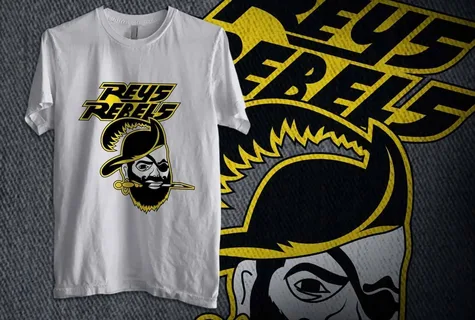Shirt transfers are a popular method for customizing garments, allowing for a wide range of designs, colors, and finishes. These methods involve transferring images, graphics, or text from a substrate onto the fabric using various techniques. Each type of transfer has unique qualities and is suited to different projects, whether you’re looking for durability, intricate detail, or vibrant colors. Here’s an overview of the different types of shirt transfers, along with their benefits and ideal uses.
Heat Transfer Vinyl (HTV)
Heat Transfer Vinyl (HTV) is one of the most common transfer methods and involves cutting designs from sheets of colored vinyl and then using a heat press to apply the design onto the fabric. The vinyl is typically available in various colors, textures, and finishes, such as matte, gloss, glitter, and metallic, offering plenty of creative flexibility.
- Best Uses: HTV is ideal for smaller, simple designs like text, logos, and single-color images. It’s often used for sports jerseys, personalized t-shirts, and simple graphics.
- Pros: HTV is durable, has vibrant color quality, and is relatively simple to apply.
- Cons: Complex designs with multiple colors can be labor-intensive and time-consuming, as each color layer must be applied separately.
Plastisol Transfers
Plastisol transfers are created by screen printing an image onto a special plastisol paper with ink. This paper is then transferred onto the fabric using a heat press. This technique combines the benefits of screen printing (such as durability and vibrant color) with the flexibility of a transfer.
- Best Uses: Plastisol transfers work well for designs that require a high level of detail, color vibrancy, and durability. They are widely used in commercial printing for brands and businesses.
- Pros: Offers long-lasting, high-quality prints similar to screen printing but is easier to store and apply in smaller batches.
- Cons: Plastisol transfers can be more expensive, and the application process requires a heat press.
The Sublimation Transfers
Sublimation transfers are popular for their ability to create vivid, full-color designs that become part of the fabric rather than sitting on top of it. Sublimation uses special inks that, when heated, turn into gas and bond with polyester fibers. This method only works on polyester garments or polyester-coated surfaces and does not work effectively on dark fabrics.
- Best Uses: Sublimation is perfect for photo-realistic prints and colorful designs on polyester shirts, sportswear, and items like mugs and phone cases.
- Pros: Sublimation transfers produce vibrant, high-resolution designs that are durable and won’t crack, peel, or fade over time.
- Cons: Limited to light-colored, polyester-based fabrics, and can be costly due to specialized equipment and inks.
Inkjet Transfers (Iron-On Transfers)
Inkjet transfers are popular for DIY projects and small batch printing. This method involves printing a design onto transfer paper using an inkjet printer, then ironing it onto the fabric. While this is an affordable and accessible method for home use, it typically lacks the durability and finish quality of professional transfers.
- Best Uses: Inkjet transfers are suitable for personal or one-time-use shirts, like custom gifts or event apparel.
- Pros: Affordable, easy to do at home, and suitable for multi-color, detailed images.
- Cons: Less durable, and designs can fade or crack after multiple washes. Results on darker fabrics require specialty transfer paper, which can impact the design’s quality.
Laser Transfer Printing
Laser transfer printing uses a laser printer to create designs on transfer paper, which is then heat-pressed onto fabric. This method provides better print quality and durability than inkjet transfers and is compatible with light and dark fabrics when using specialized papers.
- Best Uses: Laser transfer printing is commonly used for detailed and multi-colored designs on cotton, polyester, and poly-cotton blends.
- Pros: Higher print quality and durability than inkjet transfers and is cost-effective for small to medium print runs.
- Cons: Requires a laser printer and special transfer paper, which may have a higher upfront cost. The transfer can feel stiff on certain fabrics.
Direct to Film (DTF) Transfers
Direct to Film (DTF) transfers involve printing designs onto a special film, applying powder adhesive, and then heat-curing the design before transferring it to fabric. This method works on various fabrics, including cotton, polyester, blends, and even darker fabrics, making it versatile and increasingly popular.
- Best Uses: DTF transfers are suitable for detailed, multi-colored designs on almost any type of fabric.
- Pros: Highly durable, vibrant colors, and suitable for both light and dark fabrics without needing a base layer.
- Cons: Requires specialized equipment and materials, which can be costly. Some learning curve is involved in mastering this method.
Puff Transfers
Puff transfers use a special ink or vinyl that expands slightly when heat-pressed, creating a three-dimensional, raised effect. This method is often combined with HTV or screen printing to create texture and depth in designs.
- Best Uses: Puff transfers are ideal for statement logos, simple graphics, or text where a raised effect adds a unique touch.
- Pros: Adds texture and interest to designs, making them visually distinctive.
- Cons: Limited design applications and may not be suitable for intricate or multi-colored designs.
Conclusion
With the many types of shirt transfers available, selecting the best method depends on factors like design complexity, fabric type, durability, and budget. For those looking for vibrant, photo-quality prints, sublimation transfers are ideal but limited to polyester fabrics. Plastisol and DTF transfers offer durability and versatility across various fabrics, while HTV provides excellent color vibrancy for simpler designs. Inkjet and laser transfers are great for DIY projects and small runs, though they may not match the longevity of other methods.
Ultimately, understanding each transfer method’s strengths and limitations can help you choose the best approach for your project, ensuring high-quality, custom shirts that meet your needs and look fantastic.






More Stories
Everyday Events Perfect for In Glocks We Trust Clothing
SEO Company in Pakistan: Achieving Top Rankings and Success in the Digital Age
The Highly Recognized Clothing Brand adwysd